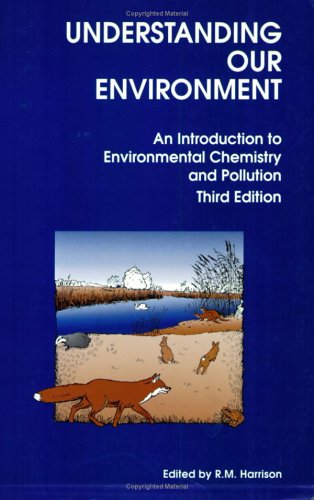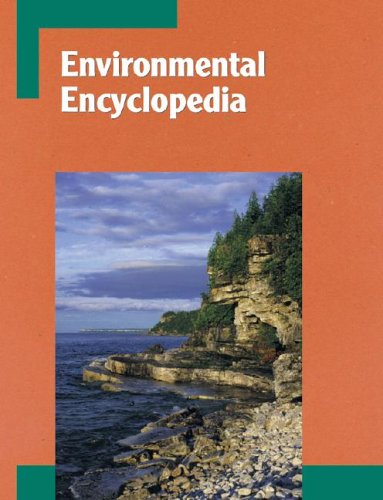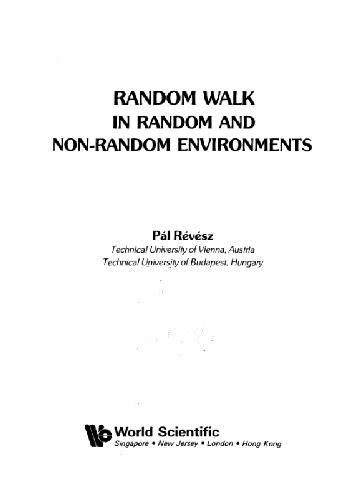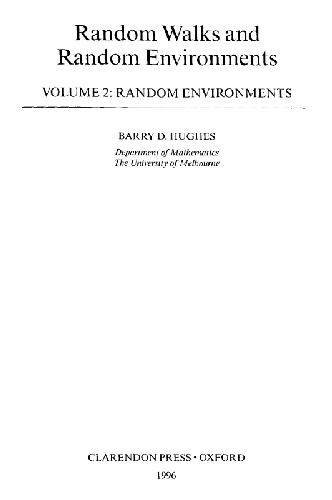R HARRISON9780854045846, 0854045848
This third edition enhances the standing of the title by developing a more international approach. Bridging all the important environmental media such as the atmosphere, fresh waters, oceans and solid earth, it also emphasizes the inter-linkages between these media. The major human and environmental impacts of pollution are summarized, and case studies are included as illustrations of the measures needed for control. Worked examples and questions are included to facilitate both teaching and learning of the subject.
This book will be essential reading for students in environmental science and related areas, as well as scientists and engineers in industry, public service and consultancy who require a basic understanding of environmental processes.
Table of contents :
Front Matter……Page 1
Preface……Page 3
Contributors……Page 5
Table of Contents……Page 0
Table of Contents……Page 6
1. The Environmental Sciences……Page 17
2. The Chemicals of Interest……Page 19
3. Units of Concentration……Page 21
5. Bibliography……Page 23
1.1.1 Troposphere and Stratosphere……Page 24
1.1.2 Atmospheric Circulation……Page 25
1.1.3 The Boundary Layer……Page 26
1.2.1 The Global Energy Balance……Page 27
1.2.3 Global Warming……Page 29
1.2.4 Climate Change……Page 32
1.2.5 International Response……Page 33
1.3.1 The Ozone Layer……Page 34
1.3.2 Ozone Depletion……Page 35
1.3.3 The Antarctic Ozone ‘Hole’……Page 36
1.3.4 Effects of International Control Measures……Page 39
2.1 Wind Speed and Direction……Page 40
2.2.1 The Lapse Rate……Page 43
2.2.2 Temperature Inversions……Page 45
2.3.1 Ground-level Concentrations……Page 46
2.3.2 Plume Rise……Page 47
2.4 Mathematical Modeling of Dispersion……Page 48
3.1.1 Introduction……Page 51
3.1.2 Sulfur Species……Page 52
3.1.3 Nitrogen Species……Page 53
3.2.1 Carbon Monoxide and Hydrocarbons……Page 54
3.2.2 Nitrogen Oxides……Page 56
3.2.4 Particulate Matter……Page 57
3.2.6 Emissions Inventories……Page 59
3.3.2 Air Quality Monitoring……Page 60
3.3.4 Vehicular Emissions – CO and Hydrocarbons……Page 63
3.3.5 Nitrogen Oxides……Page 64
3.3.6 Sulfur Oxides……Page 66
3.3.7 Vehicular Particulates……Page 67
3.3.9 Toxic Organic Micropollutants (TOMPS)……Page 68
4.1.1 Atmospheric Photochemistry and Oxidation……Page 69
4.1.2 Ozone……Page 72
4.2 Trends in Ozone Levels……Page 74
5.1.1 Particle Formation……Page 75
5.1.3 Deliquescent Behaviour……Page 76
5.1.4 Optical Properties……Page 77
5.2 Droplets and Aqueous Phase Chemistry……Page 78
5.3.1 Dry Deposition of Gases……Page 79
5.3.2 Wet Deposition……Page 80
5.3.3 Deposition of Particles……Page 81
5.4.1 Rainwater Composition……Page 82
5.4.2 The Effects……Page 83
5.4.3 Patterns of Deposition and Critical Loads Assessment……Page 84
Questions……Page 85
Color Plates……Page 87
1. Introduction……Page 91
2.1.1 Concentration and Activity……Page 94
2.1.2 Ionic Strength……Page 95
2.1.3 Equilibria and Equilibrium Constants……Page 97
2.2.1 Physical and Chemical Weathering Processes……Page 99
2.2.2 Solubility……Page 100
2.2.3 Influence of Organic Matter……Page 101
2.3.2 Hydrolysis……Page 102
2.3.3 Inorganic Complexes……Page 103
2.3.5 Organic Complexes……Page 104
2.4.1 pH as a Master Variable……Page 105
2.4.2 pepsilon as a Master Variable……Page 117
2.4.3 pepsilon – pH Relationships……Page 120
2.5 Modeling Aquatic Systems……Page 126
3.1.1 Diatom Records……Page 127
3.1.2 Aluminium……Page 128
3.1.3 Acid Mine Drainage and Ochreous Deposits……Page 129
3.1.4 Acid Mine Drainage and the Release of Heavy Metals……Page 130
3.2.1 Arsenic in Groundwater……Page 133
3.2.2 Lead in Drinking Water……Page 134
3.2.3 Cadmium in Irrigation Water……Page 135
3.2.4 Selenium in Irrigation Water……Page 136
3.2.5 Aquatic Contamination by Gold Ore Extractants……Page 138
3.3.2 Perturbatory Processes in Lake Sediments……Page 140
3.3.3 Onondaga Lake……Page 144
3.4.1 Phosphorus and Eutrophication……Page 146
3.4.2 Nitrate in Groundwater……Page 150
3.5.1 BOD and COD……Page 151
3.5.2 Synthetic Organic Chemicals……Page 152
4.1 Purification of Water Supplies……Page 155
4.2 Waste Treatment……Page 156
Questions……Page 157
Further Reading……Page 159
1.1 The Ocean as a Biogeochemical Environment……Page 160
1.2 Properties of Water and Seawater……Page 163
1.3 Salinity Concepts……Page 167
1.4 Oceanic Circulation……Page 169
2.1 Major Constituents……Page 171
2.2.1 Gas Solubility and Air-sea Exchange Processes……Page 174
2.2.2 Oxygen……Page 176
2.2.3 Carbon Dioxide and Alkalinity……Page 179
2.2.4 Dimethyl Sulfide and Climatic Implications……Page 186
2.3 Nutrients……Page 188
2.4 Trace Elements……Page 190
2.5 Physico-chemical Speciation……Page 192
3.1 Description of Sediments and Sedimentary Components……Page 199
3.2.1 Surface Charge……Page 203
3.2.2 Adsorption Processes……Page 204
3.2.3 Ion Exchange Reactions……Page 205
3.2.4 Role of Surface Chemistry in Biogeochemical Cycling……Page 206
3.3 Diagenesis……Page 207
4. Physical and Chemical Processes in Estuaries……Page 208
5. Marine Contamination and Pollution……Page 212
5.1 Oil Slicks……Page 213
5.2 Plastic Debris……Page 215
5.3 Tributyltin……Page 216
Questions……Page 219
1. Introduction……Page 221
2. Soil: Its Formation, Constituents, and Properties……Page 223
2.1 Soil Formation……Page 224
2.2 Soil Constituents……Page 225
2.2.1 The Mineral Fraction……Page 226
2.2.2 Soil Organic Matter……Page 227
2.3.1 Soil Permeability……Page 228
2.3.2 Soil Chemical Properties……Page 229
2.3.3 Adsorption and Decomposition of Organic Contaminants……Page 232
3. Sources of Land Contaminants……Page 234
4.1 Heavy Metals……Page 237
4.2 Organic Contaminants……Page 238
4.3 Sewage Sludge……Page 241
5. Possible Hazards from Contaminated Land……Page 242
6. Methods of Site Investigation……Page 243
7. Interpretation of Site Investigation Data……Page 246
8.1.2 Soil Cleaning……Page 249
8.2.1 Physico-chemical Methods……Page 250
8.2.2 Biological Methods……Page 252
9.1 Gasworks Sites……Page 253
9.2 Soil Contamination by Landfilling and Waste Disposal……Page 255
9.3 Heavy Metal Contamination from Metalliferous Mining and Smelting……Page 256
9.4 Heavy Metal Contamination of Domestic Garden Soils in Urban Areas……Page 257
10. Conclusions……Page 258
Questions……Page 259
1. Introduction: Biogeochemical Cycling……Page 260
1.1 Environmental Reservoirs……Page 262
1.2 Lifetimes……Page 263
1.2.1 Influence of Lifetime on Environmental Behaviour……Page 266
2.1 Air-land Exchange……Page 267
2.2 Air-sea Exchange……Page 270
3. Transfers in Aquatic Systems……Page 277
4. Biogeochemical Cycles……Page 280
4.1 Case Study 1: the Biogeochemical Cycle of Nitrogen……Page 282
4.2 Case Study 2: Aspects of the Biogeochemical Cycle of Lead……Page 283
5. Environmental Partitioning of Long-lived Species……Page 287
Questions……Page 288
1. Objectives of Monitoring……Page 290
2. Types of Monitoring……Page 292
2.1.3 Mobile Source Sampling for Gaseous Effluents……Page 294
2.1.5 Source Monitoring for Solid Effluents……Page 295
2.2.2 Ambient Air Monitoring……Page 297
2.2.3 Environmental Water Monitoring……Page 302
2.2.4 Sediment, Soil, and Biological Monitoring……Page 308
3.1.1 Intake Design……Page 315
3.1.2 Sample Collection……Page 317
3.2 Water Sampling Methods……Page 324
3.3 Soil and Sediment Sampling Methods……Page 326
4. Modeling of Environmental Dispersion……Page 327
4.1 Atmospheric Dispersal……Page 329
4.2 Aquatic Mixing……Page 333
5.1 Duration of Survey and Frequency of Sampling……Page 335
5.2 Methods of Reducing Sampling Frequency……Page 339
6. Prerequisites for Monitoring……Page 340
6.1 Monitoring Protocol……Page 341
6.2 Meteorological Data……Page 342
6.3 Source Inventory……Page 343
6.4 Suitability of Analytical Techniques……Page 344
6.5 Environmental Quality Standards……Page 346
7. Remote Sensing of Pollutant……Page 348
8. Presentation of Data……Page 350
Questions……Page 352
1. Introduction……Page 354
2. Toxicity: Exposure-response Relationships……Page 356
3. Exposure……Page 359
4. Absorption……Page 362
5. Internal Pathways……Page 365
6. Ecological Risk Assessment……Page 370
7. Individuals, Populations, and Communities and the Role of Biomarkers……Page 372
8. Health Effects of the Major Air Pollutants……Page 381
9. Effect of Air Pollution on Plants……Page 385
10. Ecological Effects of Acid Deposition……Page 389
11. Forest Decline……Page 396
12. Effects of Pollutants on Reproduction and Development: Evidence of Endocrine Disruption……Page 397
12.1 Eggshell Thinning……Page 398
12.2 GLEMEDS……Page 400
12.3 Marine Mammals……Page 401
12.4 Imposex in Gastropods……Page 402
12.5 Endocrine Disruptors……Page 403
13. Hydrocarbons in the Marine Environment……Page 406
14.1 Mercury……Page 411
14.2 Lead……Page 414
15. Conclusion……Page 417
Questions……Page 418
1. Introduction……Page 419
2.1 Environmental Objectives……Page 422
2.2 Environmental Standards……Page 423
2.3 Emission Limits……Page 424
2.4.1 Use-related Approach……Page 426
2.5 Specifying Standards……Page 427
2.6 Remediation Targets……Page 433
3. Legislation to Control and Prevent Pollution……Page 435
3.1 Origins of Pollution Control Legislation……Page 436
3.2 Trends in European Environmental Legislation……Page 437
3.3 Reporting Environmental Performance……Page 439
3.4 Pollution Control and Land Use Planning……Page 440
4.1 Structure and Organization of Pollution Control Agencies……Page 442
4.2 Forestalling Pollution……Page 444
4.3 Other Regulatory Action……Page 448
5.1 Alternatives to Pollution Regulation by Permit……Page 449
5.2 Tradeable Permits……Page 452
6.1 Environmental Management Systems……Page 454
6.2 Public Opinion and the Environment……Page 456
Questions……Page 457
A……Page 459
B……Page 461
C……Page 463
D……Page 465
E……Page 466
F……Page 467
G……Page 468
H……Page 469
I……Page 470
L……Page 471
M……Page 472
N……Page 474
O……Page 475
P……Page 476
Q……Page 478
R……Page 479
S……Page 480
T……Page 482
U……Page 483
W……Page 484
Z……Page 485







Reviews
There are no reviews yet.